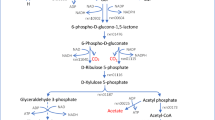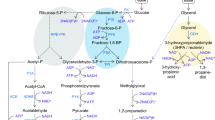Abstract
Lactococcus lactis subsp. cremoris MG1363 is a paradigm strain for lactococci used in industrial dairy fermentations. However, despite of its importance for process development, no genome-scale metabolic model has been reported thus far. Moreover, current models for other lactococci only focus on growth and sugar degradation. A metabolic model that includes nitrogen metabolism and flavor-forming pathways is instrumental for the understanding and designing new industrial applications of these lactic acid bacteria. A genome-scale, constraint-based model of the metabolism and transport in L. lactis MG1363, accounting for 518 genes, 754 reactions, and 650 metabolites, was developed and experimentally validated. Fifty-nine reactions are directly or indirectly involved in flavor formation. Flux Balance Analysis and Flux Variability Analysis were used to investigate flux distributions within the whole metabolic network. Anaerobic carbon-limited continuous cultures were used for estimating the energetic parameters. A thorough model-driven analysis showing a highly flexible nitrogen metabolism, e.g., branched-chain amino acid catabolism which coupled with the redox balance, is pivotal for the prediction of the formation of different flavor compounds. Furthermore, the model predicted the formation of volatile sulfur compounds as a result of the fermentation. These products were subsequently identified in the experimental fermentations carried out. Thus, the genome-scale metabolic model couples the carbon and nitrogen metabolism in L. lactis MG1363 with complete known catabolic pathways leading to flavor formation. The model provided valuable insights into the metabolic networks underlying flavor formation and has the potential to contribute to new developments in dairy industries and cheese-flavor research.



Similar content being viewed by others
References
Ardö Y (2006) Flavour formation by amino acid catabolism. Biotechnol Adv 24:238–242
Benthin S, Schulze U, Nielsen J, Villadsen J (1994) Growth energetics of Lactococcus cremoris FD1 during energy-, carbon-, and nitrogen-limitation in steady state and transient cultures. Chem Eng Sci 49:589–609
Branco Dos Santos F, De Vos WM, Teusink B (2013) Towards metagenome-scale models for industrial applications—the case of Lactic Acid Bacteria. Curr Opin Biotechnol 24:200–206
De Vos W (2011) Systems solutions by lactic acid bacteria: from paradigms to practice. Microb Cell Fact 10:S2
Delorme C, Godon JJ, Ehrlich SD, Renault P (1993) Gene inactivation in Lactococcus lactis: histidine biosynthesis. J Bacteriol 175:4391–4399
Dobric N, Limsowtin GK, Hillier AJ, Dudman NP, Davidson BE (2000) Identification and characterization of a cystathionine β/γ-lyase from Lactococcus lactis ssp. cremoris MG1363. FEMS Microbiol Lett 182:249–254
Durot M, Bourguignon PY, Schachter V (2009) Genome-scale models of bacterial metabolism: reconstruction and applications. FEMS Microbiol Rev 33:164–190
Duwat P, Cesselin B, Sourice S, Gruss A (2000) Lactococcus lactis, a bacterial model for stress responses and survival. Int J Food Microbiol 55:83–86
Feist AM, Herrgard MJ, Thiele I, Reed JL, Palsson BO (2009) Reconstruction of biochemical networks in microorganisms. Nat Rev Micro 7:129–143
Fernández M, Kleerebezem M, Kuipers OP, Siezen RJ, Van Kranenburg R (2002) Regulation of the metC-cysK operon, involved in sulfur metabolism in Lactococcus lactis. J Bacteriol 184:82–90
Gasson MJ (1983) Plasmid complements of Streptococcus lactis NCDO 712 and other lactic streptococci after protoplast-induced curing. J Bacteriol 154:1–9
Gómez De Cadiñanos LP, García-Cayuela T, Yvon M, Martinez-Cuesta MC, Peláez C, Requena T (2013) Inactivation of the panE gene in Lactococcus lactis enhances formation of cheese aroma compounds. Appl Environ Microbiol. doi:10.1128/AEM.00279-13
Hoefnagel MHN, Van Der Burgt A, Martens DE, Hugenholtz J, Snoep JL (2002) Time dependent responses of glycolytic intermediates in a detailed glycolytic model of Lactococcus lactis during glucose run-out experiments. Mol Biol Rep 29:157–161
Jensen PR, Hammer K (1993) Minimal requirements for exponential growth of Lactococcus lactis. Appl Environ Microbiol 59:4363–4366
Jensen NBS, Melchiorsen CR, Jokumsen KV, Villadsen J (2001) Metabolic behavior of Lactococcus lactis MG1363 in microaerobic continuous cultivation at a low dilution rate. Appl Environ Microbiol 67:2677–2682
Jensen NBS, Christensen B, Nielsen J, Villadsen J (2002) The simultaneous biosynthesis and uptake of amino acids by Lactococcus lactis studied by 13C-labeling experiments. Biotechnol Bioeng 78:11–16
Kayser A, Weber J, Hecht V, Rinas U (2005) Metabolic flux analysis of Escherichia coli in glucose-limited continuous culture. I. Growth-rate-dependent metabolic efficiency at steady state. Microbiol 151:693–706
Klamt S, Saez-Rodriguez J, Gilles E (2007) Structural and functional analysis of cellular networks with Cell NetAnalyzer. BMC Syst Biol 1:2
Kunji ERS, Mierau I, Hagting A, Poolman B, Konings WN (1996) The proteotytic systems of lactic acid bacteria. Anton Leeuwen 70:187–221
Lahtvee P-J, Adamberg K, Arike L, Nahku R, Aller K, Vilu R (2011) Multi-omics approach to study the growth efficiency and amino acid metabolism in Lactococcus lactis at various specific growth rates. Microb Cell Fact 10:12
Levering J, Musters MWJM, Bekker M, Bellomo D, Fiedler T, De Vos WM, Hugenholtz J, Kreikemeyer B, Kummer U, Teusink B (2012) Role of phosphate in the central metabolism of two lactic acid bacteria—a comparative systems biology approach. FEBS J 279:1274–1290
Linares DM, Kok J, Poolman B (2010) Genome sequences of Lactococcus lactis MG1363 (revised) and NZ9000 and comparative physiological studies. J Bacteriol 192:5806–5812
Liu M, Nauta A, Francke C, Siezen RJ (2008) Comparative genomics of enzymes in flavor-forming pathways from amino acids in lactic acid bacteria. Appl Environ Microbiol 74:4590–4600
Mahadevan R, Schilling CH (2003) The effects of alternate optimal solutions in constraint-based genome-scale metabolic models. Metabol Eng 5:264–276
Makarova K, Slesarev A, Wolf Y, Sorokin A, Mirkin B, Koonin E, Pavlov A, Pavlova N, Karamychev V, Polouchine N, Shakhova V, Grigoriev I, Lou Y, Rohksar D, Lucas S, Huang K, Goodstein DM, Hawkins T, Plengvidhya V, Welker D, Hughes J, Goh Y, Benson A, Baldwin K, Lee JH, Díaz-Muñiz I, Dosti B, Smeianov V, Wechter W, Barabote R, Lorca G, Altermann E, Barrangou R, Ganesan B, Xie Y, Rawsthorne H, Tamir D, Parker C, Breidt F, Broadbent J, Hutkins R, O’sullivan D, Steele J, Unlu G, Saier M, Klaenhammer T, Richardson P, Kozyavkin S, Weimer B, Mills D (2006) Comparative genomics of the lactic acid bacteria. Proc Nat Ac Sci 103:15611–15616
Muñoz-Tamayo R, De Groot J, Bakx E, Wierenga PA, Gruppen H, Zwietering MH, Sijtsma L (2011) Hydrolysis of β-casein by the cell-envelope-located PI-type protease of Lactococcus lactis: a modelling approach. Int Dairy J 21:755–762
Neves AR, Ramos A, Costa H, Van Swam II, Hugenholtz J, Kleerebezem M, De Vos W, Santos H (2002) Effect of different NADH oxidase levels on glucose metabolism by Lactococcus lactis: kinetics of intracellular metabolite pools determined by in vivo nuclear magnetic resonance. Appl Environ Microbiol 68:6332–6342
Notebaart R, Van Enckevort F, Francke C, Siezen R, Teusink B (2006) Accelerating the reconstruction of genome-scale metabolic networks. BMC Bioinforma 7:296
Oliveira A, Nielsen J, Forster J (2005) Modeling Lactococcus lactis using a genome-scale flux model. BMC Microbiol 5:39
Parliment TH, Kolor MG, Rizzo DJ (1982) Volatile components of Limburger cheese. J Agric Food Chem 30:1006–1008
Pastink MI, Teusink B, Hols P, Visser S, De Vos WM, Hugenholtz J (2009) Genome-scale model of Streptococcus thermophilus LMG18311 for metabolic comparison of lactic acid bacteria. Appl Environ Microbiol 75:3627–3633
Poolman B, Konings WN (1988) Relation of growth of Streptococcus lactis and Streptococcus cremoris to amino acid transport. J Bacteriol 170:700–707
Price ND, Reed JL, Palsson BO (2004) Genome-scale models of microbial cells: evaluating the consequences of constraints. Nat Rev Micro 2:886–897
Rijnen L, Bonneau S, Yvon M (1999) Genetic characterization of the major lactococcal aromatic aminotransferase and its involvement in conversion of amino acids to aroma compounds. Appl Environ Microbiol 65:4873–4880
Schellenberger J, Que R, Fleming RMT, Thiele I, Orth JD, Feist AM, Zielinski DC, Bordbar A, Lewis NE, Rahmanian S, Kang J, Hyduke DR, Palsson BO (2011) Quantitative prediction of cellular metabolism with constraint-based models: the COBRA Toolbox v2.0. Nat Prot 6:1290–1307
Smid EJ, Konings WN (1990) Relationship between utilization of proline and proline-containing peptides and growth of Lactococcus lactis. J Bacteriol 172:5286–5292
Smit BA, Engels WJM, Wouters JTM, Smit G (2004) Diversity of l-leucine catabolism in various microorganisms involved in dairy fermentations, and identification of the rate-controlling step in the formation of the potent flavour component 3-methylbutanal. Appl Microbiol Biotechnol 64:396–402
Smit G, Smit BA, Engels WJM (2005) Flavour formation by lactic acid bacteria and biochemical flavour profiling of cheese products. FEMS Microbiol Rev 29:591–610
Starrenburg MJC, Hugenholtz J (1991) Citrate fermentation by Lactococcus and Leuconostoc spp. Appl Environ Microbiol 57:3535–3540
Tanous C, Gori A, Rijnen L, Chambellon E, Yvon M (2005) Pathways for alpha-ketoglutarate formation by Lactococcus lactis and their role in amino acid catabolism. Int Dairy J 15:759–770
Taymaz-Nikerel H, Borujeni AE, Verheijen PJT, Heijnen JJ, Van Gulik WM (2010) Genome-derived minimal metabolic models for Escherichia coli MG1655 with estimated in vivo respiratory ATP stoichiometry. Biotechnol Bioeng 107:369–381
Teusink B, Wiersma A, Molenaar D, Francke C, De Vos WM, Siezen RJ, Smid EJ (2006) Analysis of growth of Lactobacillus plantarum WCFS1 on a complex medium using a genome-scale metabolic model. J Biol Chem 40041–40048
Verouden MPH, Notebaart RA, Westerhuis JA, Van Der Werf MJ, Teusink B, Smilde AK (2009) Multi-way analysis of flux distributions across multiple conditions. J Chemom 23:406–420
Vido K, Le Bars D, Mistou M-Y, Anglade P, Gruss A, Gaudu P (2004) Proteome analyses of heme-dependent respiration in Lactococcus lactis: involvement of the proteolytic system. J Bacteriol 186:1648–1657
Vos P, Simons G, Siezen RJ, De Vos WM (1989) Primary structure and organization of the gene for a procaryotic, cell envelope-located serine proteinase. J Biol Chem 264:13579–13585
Wegmann U, O’connell-Motherway M, Zomer A, Buist G, Shearman C, Canchaya C, Ventura M, Goesmann A, Gasson MJ, Kuipers OP, Van Sinderen D, Kok J (2007) Complete genome sequence of the prototype lactic acid bacterium Lactococcus lactis subsp. cremoris MG1363. J Bacteriol 189:3256–3270
Wegmann U, Overweg K, Jeanson S, Gasson M, Shearman C (2012) Molecular characterization and structural instability of the industrially important composite metabolic plasmid pLP712. Microbiol 158:2936–2945
Yvon M (2006) Key enzymes for flavour formation by lactic acid bacteria. Aust J Dairy Technol 61:88–96
Yvon M, Rijnen L (2001) Cheese flavour formation by amino acid catabolism. Int Dairy J 11:185–201
Yvon M, Chambellon E, Bolotin A, Roudot-Algaron F (2000) Characterization and role of the branched-chain aminotransferase (BcaT) isolated from Lactococcus lactis subsp. cremoris NCDO 763. Appl Environ Microbiol 66:571–577
Author information
Authors and Affiliations
Corresponding author
Rights and permissions
About this article
Cite this article
Flahaut, N.A.L., Wiersma, A., van de Bunt, B. et al. Genome-scale metabolic model for Lactococcus lactis MG1363 and its application to the analysis of flavor formation. Appl Microbiol Biotechnol 97, 8729–8739 (2013). https://doi.org/10.1007/s00253-013-5140-2
Received:
Revised:
Accepted:
Published:
Issue Date:
DOI: https://doi.org/10.1007/s00253-013-5140-2




